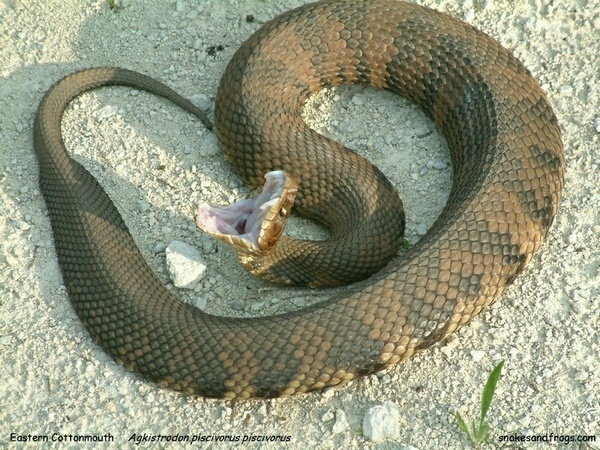VENOMOUS
Cottonmouth Snake
Agkistrodon piscivorus
|
|
Family: Crotalidae - Pitviper Snakes (dangerously venomous) Typical Adult Size: 30 to 48 inches Reproduction: live bearing Eye Pupil: elliptical Dorsal Scales: keeled Anal Scale: single |
|
The Eastern Cottonmouth, Agkistrodon p. piscivorus, is the predominant subspecies found in South Carolina. Intergrades with the Florida Cottonmouth, Agkistrodon p. conanti, can be found in the extreme southern portion of the State. The Florida subspecies has more prominent facial markings than the Eastern subspecies. Cottonmouths are large, aquatic, venomous snakes. They are generally dark above: olive, brown, or black. A lighter/darker cross banding pattern may be seen, especially on the sides. They are heavy bodied with keeled scales. Adult size is considered to be in the range of 30 to 48 inches. The young are more distinctly patterned than adults. Cottonmouths are common snakes found in wetlands, rivers, lakes, etc. Their range in South Carolina is usually limited to below the fall line. Many times non-venomous water snakes are mistaken for Cottonmouths. Cottonmouths get their name from their defensive habit of gaping their mouths open to expose the white lining of the mouth. This is their way of warning potential aggressors to stay away. Cottonmouths can be aggressive. Unlike their Copperhead cousins, they will often stand their ground. Their venom is stronger and they tend to be larger snakes, making them very dangerous. I have encountered specimens which flee like water snakes, but more often they assume a defensive posture or crawl/swim slowly away. A number of years ago, while trudging through the floodplain of the Congaree River below Columbia, SC, I had my most unusual encounter with a Cottonmouth. It was spring and the river bottoms held many depressions and drainageways filled with water. I was alone, which is not especially smart when you are miles from the nearest highway. I had seen several Cottonmouths earlier, but had not tried to catch them. I was carrying a walking stick with a rawhide loop. The Cottonmouths' aggressive behavior makes them fairly easy to capture using the stick and loop method. As I passed a fairly large pool, I saw the intermittent rises of a snake's body in the water about 15 feet from the bank. I identified the pattern as being that of a Cottonmouth. The snake was not moving. I could see several lengths of the body floating. From the spacing and diameter of the exposed lengths I knew I was seeing a very long snake. In fact, I judged its total length to be 8 feet or longer! Now this was really extraordinary since the longest recorded specimen was barely longer than 6 feet. My heart was really thumping. I could see no way to capture the snake with my little loop stick. The water where the snake floated was surely more than waist-deep. It would really be dumb to enter water that deep with such a dangerous animal. Still the snake did not move. I finally decided that if I could not capture the snake, at least I could get a better look at it. I found a long tree limb to prod the snake with. Maybe I would get lucky and, rather than swimming away, the snake would crawl onto the bank where I might have a chance to capture it. I poked at the snake with the limb. It did not move. Well, a dead 8-foot long Cottonmouth would still be a very great find. Using the limb, I was able to pull the snake closer to the shore. Then I was able to see that I did not have an 8-foot Cottonmouth afterall. There was a Cottonmouth, but it was only about 4 feet long. But that was not all I had. The Cottonmouth was biting the tail of a Brown Water Snake of at least equal length! I pulled both snakes onto the shore. Both were probably dead, although there was some residual muscle movement left. On the shore, the Cottonmouth still was connected with the water snake. Upon close examination, one of the Cottonmouth's fangs protruded through the tail of the water snake, within a few inches of the end. Studying the situation, I came to the following conclusion. The Cottonmouth had spied the water snake's tail and thought it was a small snake which would make a nice meal. The Cottonmouth had grasp the tail, probably from the side. The water snake had attempted to flee, pulling the Cottonmouth's fang through the tough skin on its tail. The two snakes were then firmly attached together. With both snakes being of essentially the same size, a tug-of-war ensued with no winner. In the water, both snakes had struggled to exhaustion and drowned. |
